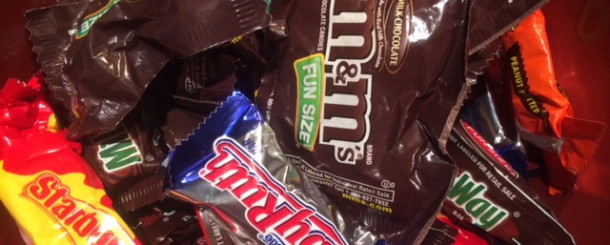Most of us practice (or at least try to practice) moderation when it comes to enjoying Halloween candy. If you’re like me, after Halloween night, you try to slowly dole out the trick-or-treating stash, allowing yourself and your kids one or two pieces a day until everyone loses interest, and then you put the candy away in your kitchen.
However, with this slow eating approach, it’s possible that at least some of the candy will go bad before your family gets a chance to enjoy it. The good news, however, is that there are a number of ways to extend the life of candy, including the four strategies from the National Confectioners Association that make up today’s hint.
1. Know where to store your candy. According to the National Confectioners Association, the pantry is generally a good place to store your extra sweets, assuming your pantry is cool and you have the goodies in some sort of airtight storage. And the association says the basement is another good storage area, as most candies tend to last longer when stashed away in cool, dark and dry spots.
2. Keep shelf life in mind. Assuming you stored your candy smartly, different types of sweets stay fresh for different amounts of time, according to the National Confectioners Association. Dark chocolates wrapped in foil, for instance, can last for one to two years, while milk and white chocolates typically last for eight to ten months. Meanwhile, hard candy and unopened soft sweets can last about a year; unopened candy corn has a shelf life of about nine months.
 3. Don’t mix certain treats. The association also advises against storing candies that absorb moisture (think caramels, mints and hard candies) with candies that lose moisture (like fudge and creamy candies). If they’re stored in the same container, the harder candies will likely become sticky. Instead, make sure softer treats (like taffies, caramels and nougats) are “wrapped individually with clear cellophane” and sprinkle hard candies “with finely ground sugar and store in an air-tight jar.”
3. Don’t mix certain treats. The association also advises against storing candies that absorb moisture (think caramels, mints and hard candies) with candies that lose moisture (like fudge and creamy candies). If they’re stored in the same container, the harder candies will likely become sticky. Instead, make sure softer treats (like taffies, caramels and nougats) are “wrapped individually with clear cellophane” and sprinkle hard candies “with finely ground sugar and store in an air-tight jar.”
4. Freeze selectively. Not all candies hope up equally well in the freezer. The confectioners association says that while toffee and truffles can be frozen for up to 2 months, candy with fruits and nuts tends not to hold up as well in the freezer. Though, as Nurse Judy from my pediatrician’s office points out, frozen Snickers do still taste good (just try not to keep them in the freezer too long).
To be sure, many people don’t like to have loads of candy around their house and prefer to limit how much candy their kids can collect on Halloween in the first place. There also are easy ways to get rid of extra candy, like selling it to the local dentist’s office or trading it in to mom and dad for a toy. And of course, some people have no problem eating all of their candy.
But if you find your candy gets stale before you get a chance to enjoy it, the four tips above are worth following. And you’ll even save yourself some money in the process, assuming you always like to have fresh candy around to snack on.
What are your tricks for keeping Halloween candy fresh? What do you do with your children’s trick-or-treat sweet stashes and why?
Follow Hint Mama on Facebook and Twitter, and read more about her and her disclosures.







We put our candy in a brown paper bag inside a ziploc bag and store it up high on a shelf, away from kids and dogs! The microwave oven can be a good place to store baked goods that shouldn’t be refrigerated, like cupcakes. Be careful of pests if storing something in lower cupboards, drawers, or places like the basement!